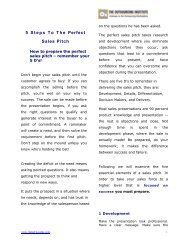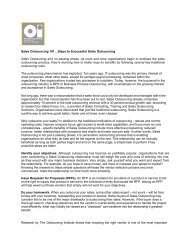The Business Process Outsourcing Agreement - The Outsourcing ...
The Business Process Outsourcing Agreement - The Outsourcing ...
The Business Process Outsourcing Agreement - The Outsourcing ...
Create successful ePaper yourself
Turn your PDF publications into a flip-book with our unique Google optimized e-Paper software.
K&E 10200796.2<br />
1. Under an exclusive arrangement, the customer may neither hire another service provider<br />
to perform the same services the service provider is providing under the agreement, nor<br />
perform those same services itself. This type of arrangement may be characterized as a<br />
requirements contract.<br />
2. Under a sole arrangement, the customer may not hire another service provider to perform<br />
the services but the customer may perform the services itself.<br />
3. To the extent that the service provider is not an exclusive or sole provider of a service,<br />
the agreement may grant the service provider a right of first refusal (i.e., the customer<br />
makes all submitted bids available to the service provider and the service provider has the<br />
option of meeting the best bid) or a right to submit the first bid for such service.<br />
4. <strong>The</strong> parties may also agree to granting the service provider “preferred provider status” if<br />
the agreement does not contemplate an exclusive or first bid arrangement. “Preferred<br />
provider status” confers on the service provider a right to bid on future projects without<br />
re-submitting its qualifications to the customer and generally means that, all other things<br />
being substantially equal, the service provider should be offered the project.<br />
5. Nonexclusivity allows the customer to do the work itself or to use another service<br />
provider.<br />
6. Exclusivity does not need to be determined for the outsourcing project in its entirety. <strong>The</strong><br />
parties may agree to a hybrid arrangement whereby exclusivity varies according to one or<br />
more of the following:<br />
(i) a given geographical area (e.g., for the customer’s functions in the United States);<br />
(ii) certain specified functions (e.g., for the customer’s payroll and accounting<br />
functions but not for the development or maintenance of related applications); or<br />
(iii) certain of the customer’s business units, affiliates, suppliers and customers (e.g.,<br />
for all future business units, affiliates, suppliers and customers of the customer that<br />
do not already have a third party service provider providing the same services).<br />
7. It is important to note that, irrespective of the legal status of the outsourcing arrangement,<br />
many outsourcing arrangements/relationships will be de facto requirements contracts, at<br />
least in the short-term.<br />
D. Change. Since most business process outsourcing arrangements contemplate a relatively longterm<br />
relationship, it is important that the agreement address the procedures to be followed when<br />
circumstances change. <strong>The</strong> agreement must be sensitive to the interrelationship among price, the<br />
scope of service and service levels. To this end, the agreement should include:<br />
(i) change control procedures;<br />
(ii) a definition of change (e.g., a requirement for a specified number of transactions<br />
or resources that are above or below defined “bandwidths” of numbers of<br />
transactions or resources required to perform the services); and<br />
3 Kirkland & Ellis LLP




